The Saccade Explained: Decoding the Eye Movements You See at the Bedside
As physical therapists specializing in vestibular and balance disorders, we dedicate ourselves to dissecting complex patient presentations. We observe subtle eye movements, interpret nuanced tests, and translate intricate neurophysiology into actionable treatment plans. But let's be honest: the jargon around eye movements, especially saccades and nystagmus, often feels like a dizzying whirlwind itself.
During your bedside exam, what exactly are you looking for when a patient's eyes dart? Is it a repositioning saccade? A catch-up saccade? Is it simply the fast phase of nystagmus? Why do we even use these specific terms, and what do they truly mean? Understanding this terminology isn't just academic; it sharpens your diagnostic precision and solidifies your treatment rationale.
What is a Saccade? The Eye's Fundamental Jump
First, let's establish our baseline. A saccade is a rapid, ballistic eye movement. Your brain initiates these fast shifts to bring a new image onto the fovea, the part of your retina responsible for sharp, detailed vision. These eye movements are rapid, sometimes reaching speeds of over 700 degrees per second, and once initiated, their trajectory remains unchangeable. You make these jumps constantly and voluntarily, whether reading text (your eyes jump from word to word), scanning a room for a friend, or consciously directing your attention to a specific object. We call these volitional saccades—conscious, goal-directed eye movements initiated by your higher cortical centers. They enable your visual system to explore your environment and focus on areas of interest with impressive speed and precision. However, in the vestibular clinic, we primarily focus on a different type of saccade. This is where the specific terminology becomes vital.
Repositioning Saccade vs. Catch-Up Saccade: The Bedside Revelation
When discussing abnormal eye movements associated with dizziness, we encounter terms such as repositioning saccade and catch-up saccade. These terms describe essentially the same phenomenon, emphasizing different aspects of its purpose and context:
A repositioning saccade repositions the eye. It is the rapid, corrective eye movement that brings your gaze back to a target after it has drifted away. This happens involuntarily when your gaze stability system fails.
A catch-up saccade refers explicitly to the eye's movement to catch up with a moving target, or more commonly, to return to its original position after the vestibulo-ocular reflex (VOR) fails to maintain fixation during head movement. They catch up the image to your fovea.
Most importantly, this type of saccade is the fast component of nystagmus. When you observe nystagmus, you are seeing a repetitive cycle: a slow, involuntary drift of the eyes (the slow phase) followed by a rapid, involuntary correction (the fast phase, which is your repositioning/catch-up saccade). The slow phase reflects the underlying pathological signal, and the fast phase represents the brain's attempt to reset the eye to maintain some level of visual function.
We use these specific terms because they convey the purpose and involuntary nature of the eye movement in response to a deficit. Unlike a volitional saccade you consciously choose to make, these are the brain's automatic, urgent attempts to restore clear vision and reduce oscillopsia (the illusory movement of the visual world). They act as a critical signpost for underlying dysfunction.
The Neurally Active Ear: The Underlying Driving Force
To understand why these repositioning saccades occur and why they beat in a particular direction, you must grasp the concept of the neurally active ear. Each of your inner ears maintains a continuous, baseline level of neural activity, a tonic firing rate, even when your head remains still. This tonic firing rate, typically around 90-100 pulses per second, creates a balanced signal from both sides, which your brain interprets as a stable head. Your brain constantly compares these signals from both ears, much like a neurological tug-of-war.
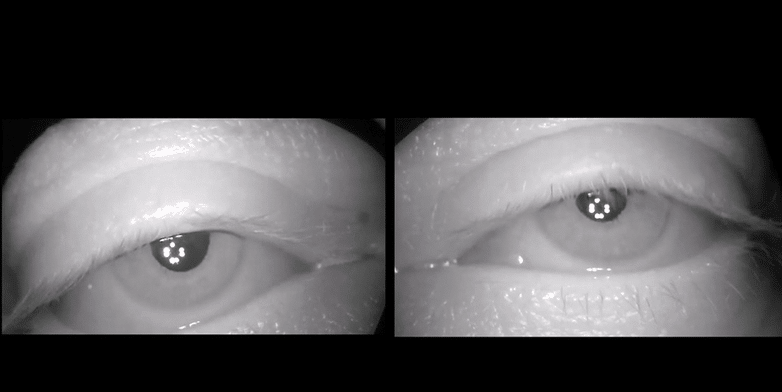
However, if one inner ear or its nerve suffers damage—as in a unilateral vestibular hypofunction (UVH) or even BPPV in a provocative position—that ear's tonic firing rate drops. Suddenly, the healthy ear sends a relatively higher level of neural activity. This creates an asymmetrical neural tone. The ear with the comparatively stronger, healthier signal becomes your neurologically active ear. This asymmetry is the fundamental peripheral problem, disrupting the delicate balance of vestibular input to the central nervous system.
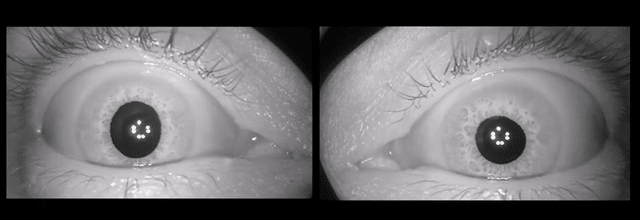
Peripheral Asymmetry and Central Compensation: The Full Picture
Here is how the system responds to this peripheral problem and generates the corrective saccade:
The Peripheral Problem: A damaged ear sends a deficient signal. If your right ear suffers from hypofunction, for instance, its resting tonic firing rate is significantly lower than that of the healthy left ear. This creates a constant, pathological imbalance in the signals reaching the brainstem's vestibular nuclei.
The Perceived Head Movement: Your central nervous system, receiving this imbalanced input, interprets it as if your head is continuously turning towards the lesioned side (e.g., towards the right, if the right ear is weak). This is a false sensation of movement.
The Slow Phase of Nystagmus: This perceived slow head movement then drives your eyes to slowly drift away from the more neurally active side (e.g., if the left ear is more active, your eyes slowly drift left). This slow drift occurs because the vestibulo-ocular reflex (VOR), which stabilizes typical gaze during head movements, cannot function correctly with the asymmetrical input. This is the slow phase of the nystagmus—the ocular manifestation of the brain's misinterpretation and the VOR's failure.
The Brain's Urgent Correction: The Repositioning Saccade: As your eyes slowly drift off target, the visual image of the world slips across your fovea. This retinal slip generates a powerful visual error signal that your brain cannot ignore. Your brain, wired for stable, clear vision and minimal oscillopsia, demands immediate correction. It rapidly generates a repositioning saccade (also known as your fast phase or catch-up saccade) to snap your eyes back onto the target.
Crucially, because your eyes drifted away from the more neurally active ear, the corrective repositioning saccade must beat back towards that more neurally active ear to restore foveal fixation. This is the central compensatory mechanism in action, striving to return your gaze to a stable, resting state and maintain the clarity of your visual world despite the faulty peripheral input.
The Head Impulse Test (HIT): Why This Saccade is Your Primary Focus
In the majority of your bedside exams, you are actively looking for this very saccadic eye motion. The HIT specifically assesses the high-frequency function of the VOR. Consider a patient with a right unilateral vestibular hypofunction (RUH):
When you perform a rapid head impulse to the right, you activate the impaired right horizontal semicircular canal. Because the right ear is damaged, it cannot produce the necessary robust excitatory response to that rapid head turn. Its signal output is weak, failing to match the speed of the head movement. Consequently, your patient's vestibulo-ocular reflex (VOR) for rightward head movements is deficient, characterized by a reduced VOR gain (i.e., eye velocity/head velocity ratio). Their eyes cannot maintain fixation and instead slip off target, moving with the head to the right. As the eyes slip, the brain detects the visual error and fires off a repositioning saccade (a catch-up saccade, the fast phase of the nystagmus) to bring the eyes back to the target. Since the eyes slipped to the right, this corrective saccade returns to the left, which is the direction of the more neurally active (healthy) ear.
This observation, the presence of that particular saccade, is a positive HIT and unequivocally points to a right-sided vestibular deficit. This repositioning saccade is your central nervous system's visible attempt to compensate for the peripheral failure, and its presence indicates a significant VOR impairment to the side of the head thrust. It is the core finding you seek. Note that while overt saccades are visible, more subtle covert saccades can also occur during the head movement, also indicating a VOR deficit.
What You See in Other Conditions: The Saccade's Signature
To further illustrate the importance of this saccadic motion, let's consider what you observe in other common vestibular scenarios:
Unilateral Hypofunction (Spontaneous Nystagmus)
When a patient has a static unilateral vestibular hypofunction, they often exhibit spontaneous nystagmus at rest. This occurs due to the constant, pathological tonic imbalance from the damaged ear. The eyes slowly drift towards the lesioned side (the slow phase, away from the neurally active ear) and then rapidly snap back towards the healthy, more neurally active ear (the fast phase, the repositioning saccade).
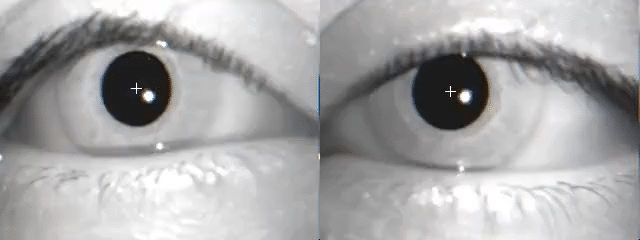
Optokinetic Nystagmus (OPK)
Optokinetic nystagmus is a normal physiological response. It helps stabilize your image of the world when you move through it (like watching telephone poles pass from a train window). Your eyes smoothly track a moving visual field (smooth pursuit, the slow phase) until they reach their orbital limit or lose the target, then they quickly jump back to pick up a new target (a corrective saccade, the fast phase). This is a continuous cycle of tracking and saccadic resetting.
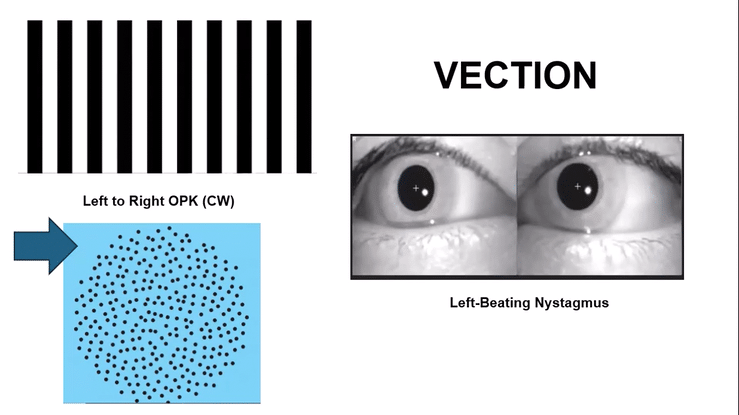
Benign Paroxysmal Positional Vertigo (BPPV) - During Provocative Testing (e.g., Dix-Hallpike)
In BPPV, displaced otoconia (calcium carbonate crystals) move within a semicircular canal. When you place a patient in a specific provocative position (such as the Dix-Hallpike Test for PSC-BPPV), these dislodged crystals move, creating abnormal fluid displacement within the canal. This abnormal fluid movement generates a pathological signal from the affected ear, causing an acute, transient vestibular imbalance. This imbalance then drives a characteristic nystagmus, which includes a slow phase (eye drift) and a fast phase (the repositioning saccade) that helps confirm the diagnosis and localize the affected canal. The rapid phase typically has a specific direction (upbeating, downbeating, torsional) depending on the canal involved.
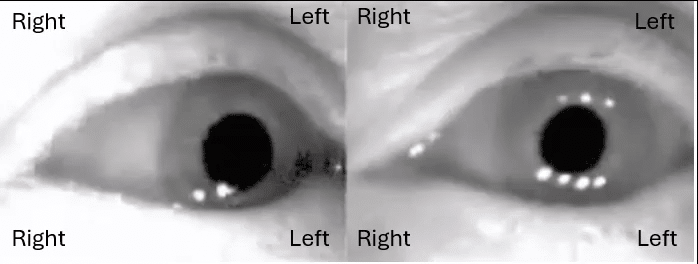
Normal Saccade (During a Normal Head Impulse Test)
When you perform a rapid head impulse on a patient with a healthy vestibular system, their VOR functions perfectly. Their eyes maintain a stable gaze on the target throughout the rapid head movement, equally and oppositely moving to the head. This means their brain receives balanced and appropriate signals from both inner ears, allowing for seamless gaze stabilization. In this scenario, you observe no corrective repositioning or catch-up saccades. This absence of saccades is precisely what you look for to confirm normal VOR function.
Why This Saccade is So Important
This specific saccadic eye motion you identify at the bedside is not just an arbitrary flicker; it is the beacon guiding your every clinical decision. Understanding what the repositioning/catch-up saccade is, why we use these terms, and why it appears as it does in vestibular dysfunction, unlocks a deeper level of diagnostic and therapeutic mastery. This comprehension empowers you to:
Diagnose with Precision: Confidently identify the side of the lesion and the nature of the vestibular deficit.
Educate patients effectively by explaining their symptoms clearly and logically, thereby building trust and compliance.
Target Treatment Precisely: Develop rehabilitation strategies that directly address the root cause and capitalize on the brain's remarkable capacity for compensation and adaptation.
Every heartbeat tells a story. Learn to listen to these stories, and you will elevate your practice to new heights.
Brian K. Werner, PT, MPT, has been a physical therapist specializing in vestibular issues for over 25 years and is the National Director of Vestibular Education & Training at FYZICAL. He is also a prolific writer, sharing his expertise through his Substack articles.






